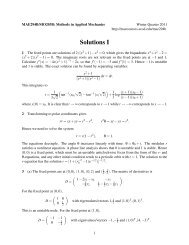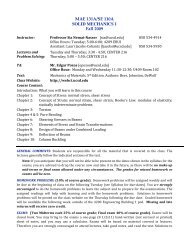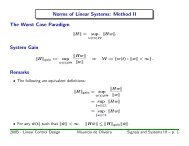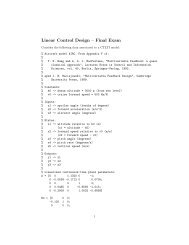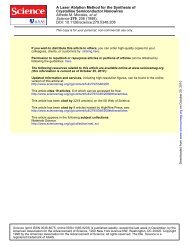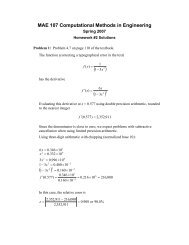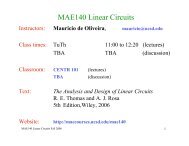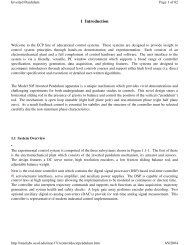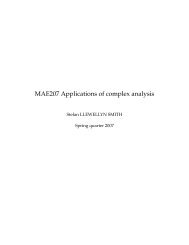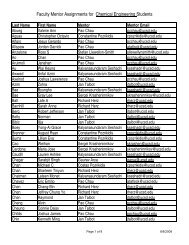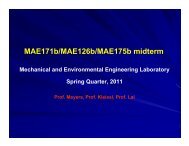Scientific American article
Scientific American article
Scientific American article
Create successful ePaper yourself
Turn your PDF publications into a flip-book with our unique Google optimized e-Paper software.
LAURIE GRACE<br />
a b c<br />
VORTEX<br />
near the lab window. The real surprise<br />
came when the dolphin swam away<br />
from the window and made several<br />
fluke vortex rings—so different from<br />
what we each blew at the window.<br />
Our study of the bottlenose dolphins<br />
at Sea Life Park Hawaii continues in<br />
the hope of better understanding their<br />
behavior. As the only nonprimates that<br />
have shown strong indications of self-<br />
The Authors<br />
KEN MARTEN, KARIM SHARIFF, SUCHI PSARAKOS and<br />
DON J. WHITE have worked together in the study of dolphin<br />
rings for the past two years. Marten, who studies bioacoustics as<br />
well as dolphin behavior, is director of research for Project Delphis<br />
at Earthtrust. Shariff specializes in fluid dynamics at the National<br />
Aeronautics and Space Administration Ames Research<br />
Center. Psarakos is the computer scientist and co-director of the<br />
wild dolphin research project at Project Delphis. White founded<br />
Earthtrust in 1976 to promote the conservation of marine mammals;<br />
he is currently spearheading a new campaign in the area of<br />
nonintrusive dolphin research and public education. The authors<br />
gratefully acknowledge the support of the staff at Sea Life Park<br />
Hawaii. Information on Earthtrust is available from earthtrust@aloha.net<br />
or 25 Kaneohe Bay Drive, Kailua, HI 96734.<br />
awareness, these dolphins may teach us<br />
about the nature of intelligence through<br />
their experimentation and play. But as<br />
we consider their remarkable abilities,<br />
we are haunted by the knowledge that<br />
many cultures, including our own, regard<br />
dolphins as expendable. Dolphins<br />
continue to be targeted by tuna nets, to<br />
become ensnared in expansive drift nets<br />
and gill nets, to be canned as mock<br />
HORIZONTALLY MOVING RING forms<br />
when a dolphin flicks its tail while swimming<br />
on its side. The horizontal and slightly downward<br />
motion of the fin creates a vortex traveling<br />
in the same direction (a). The dolphin then<br />
turns around and injects air into the swirling<br />
flow (b); the air is drawn along the core of the<br />
vortex (c), forming a ring that moves in the direction<br />
of flow through its center. The adult<br />
female Laka is pictured (left) exhaling into the<br />
vortex and examining her creation.<br />
whale meat and to be shot for crab bait<br />
or to be hunted for sport. Earthtrust and<br />
its sponsors work to address these issues,<br />
but we believe only a basic change<br />
in human behavior will make a permanent<br />
difference. It is our fervent hope<br />
that by providing new views into the<br />
dolphin mind, we may yet convince people<br />
to stop the indiscriminate slaughter<br />
of these fascinating creatures.<br />
SA<br />
Further Reading<br />
Vortex Ring Bubbles. T. S. Lundgren and N. N. Mansour in Journal<br />
of Fluid Mechanics, Vol. 225, pages 177–196; March 1991.<br />
Evidence of Self-Awareness in the Bottlenose Dolphin (TUR-<br />
SIOPS TRUNCATUS). Ken Marten and Suchi Psarakos in Self-Awareness<br />
in Animals and Humans: Developmental Perspectives. Edited by S. T.<br />
Parker, R. W. Mitchell and M. L. Boccia. Cambridge University Press,<br />
1994.<br />
Using Self-View Television to Distinguish between Self-Examination<br />
and Social Behavior in the Bottlenose Dolphin (TUR-<br />
SIOPS TRUNCATUS), by Ken Marten and Suchi Psarakos, pages 205–<br />
224, and related <strong>article</strong>s on animal consciousness in Consciousness<br />
and Cognition, Vol. 4, No. 2, pages 205–269; June 1995.<br />
General information on dolphin cognition research and the organization<br />
Earthtrust is available on the World Wide Web at http://earthtrust.org<br />
Ring Bubbles of Dolphins <strong>Scientific</strong> <strong>American</strong> August 1996 87<br />
Copyright 1996 <strong>Scientific</strong> <strong>American</strong>, Inc.



